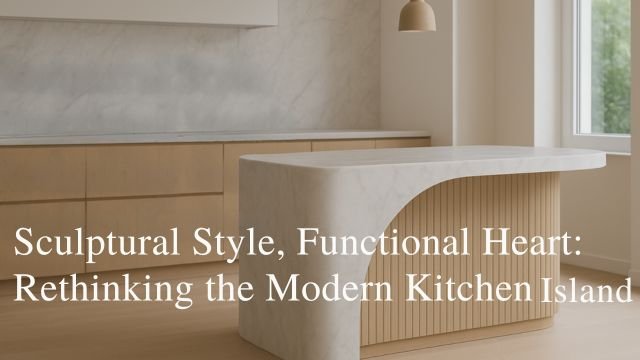There’s something quietly revolutionary happening in kitchens across the UK. No longer content with standard rectangular blocks, homeowners and designers are reinventing the modern kitchen island into something bolder, softer, and far more expressive. These aren’t just prep stations anymore, they’re functional sculptures that anchor the entire space, inviting connection, offering storage and tech, and looking like bespoke furniture. If you’re planning a renovation or dreaming up your next home project, the modern kitchen island is where to start.
At its core, the modern kitchen island is a multitasker. It bridges open-plan living, giving structure without creating walls. It hosts breakfast, homework, wine chats, and late-night snacks. But what’s changed is how it looks and feels. Instead of harsh edges and flat-panel cupboards, we’re seeing a rise in curves, fluted textures, monolithic slabs, and floating forms that bring character without cluttering the room. According to several 2025 interior forecasts, sculptural islands are now the most-requested kitchen upgrade, surpassing even walk-in pantries and statement lighting.
Curves are leading the charge. A curved kitchen island softens traffic flow, invites interaction, and reduces those all-too-familiar hip bruises in tighter layouts. Rounded edges can feel retro or ultra-modern depending on your finish—think smooth marble arcs with reeded oak facing, or powder-coated metal cladding with an industrial twist. Fluted details, particularly in timber, are giving islands rhythm and depth, catching the light throughout the day while hiding fingerprints better than gloss finishes ever could.
Another favourite feature is the waterfall countertop. When a slab of quartz or marble spills over the sides of an island, it makes a clean, dramatic statement. It looks simple, but it takes careful craftsmanship and comes at a cost—you’re essentially using triple the material. Still, if you want your island to be the room’s centrepiece, a waterfall edge in a boldly veined stone is a timeless way to achieve it.
For those craving minimalism, the monolithic island is the boldest route. Picture a single block of stone, wood, or concrete with no visible hardware or interruption. It’s sleek, yes, but also heavy—visually and literally. To counterbalance the mass, some designers are lifting parts of the island on legs, or building in open voids and slim shelving to keep the footprint feeling light. Floating or cantilevered kitchen islands also achieve this sense of weightlessness, particularly when paired with recessed lighting or concealed toe kicks. The illusion? A slab that seems to hover mid-air.
Form is one thing, but function matters too. Today’s modern kitchen islands often hide power sockets, recycling drawers, integrated appliances, or even banquette seating on the far side. A great island doesn’t just look good—it works hard. Whether you’re plugging in a laptop, charging your phone, or tucking in for a quick lunch, the best islands make multitasking feel effortless. Make sure to plan generous circulation space around it—at least a metre on each side is ideal. In a small kitchen, go for a rounded or oval form that guides traffic smoothly around its edges.
Sustainability is also shaping modern kitchen island choices. Many homeowners are swapping tropical hardwoods and high-VOC sealants for recycled paper composites, FSC-certified timber, and sintered stone surfaces that mimic marble but offer greater durability. Bamboo fronts, terrazzo-style recycled glass counters, and even reclaimed wood accents are not only eco-friendly but add story and texture to the room. With a few clever swaps, you can have an island that’s as green as it is gorgeous.
Of course, not all trends suit all homes. If you’re updating a period property, a curved fluted island in warm oak might feel more natural than a sharp monolith in concrete. If you love bright colours, consider painting your island cabinetry in a soft sage, deep navy or rich ochre for a subtle statement that won’t date too quickly. Remember, the modern kitchen island isn’t a passing trend, it’s a reflection of how we cook, gather, and live now. Choose materials and shapes that will stand up to time, use, and a little bit of joyful mess.
Ultimately, what makes a modern kitchen island truly modern isn’t just its look. It’s the way it holds your home together, quietly making life easier and more beautiful every day. From morning coffees to family dinners, late-night baking to last-minute homework, the island is there. So shape it well, build it bold, and make it yours.


